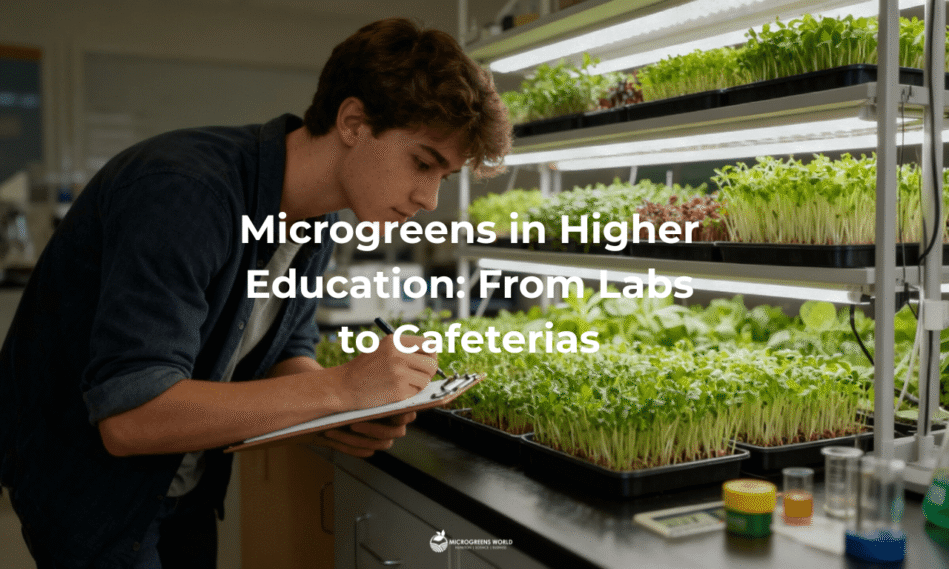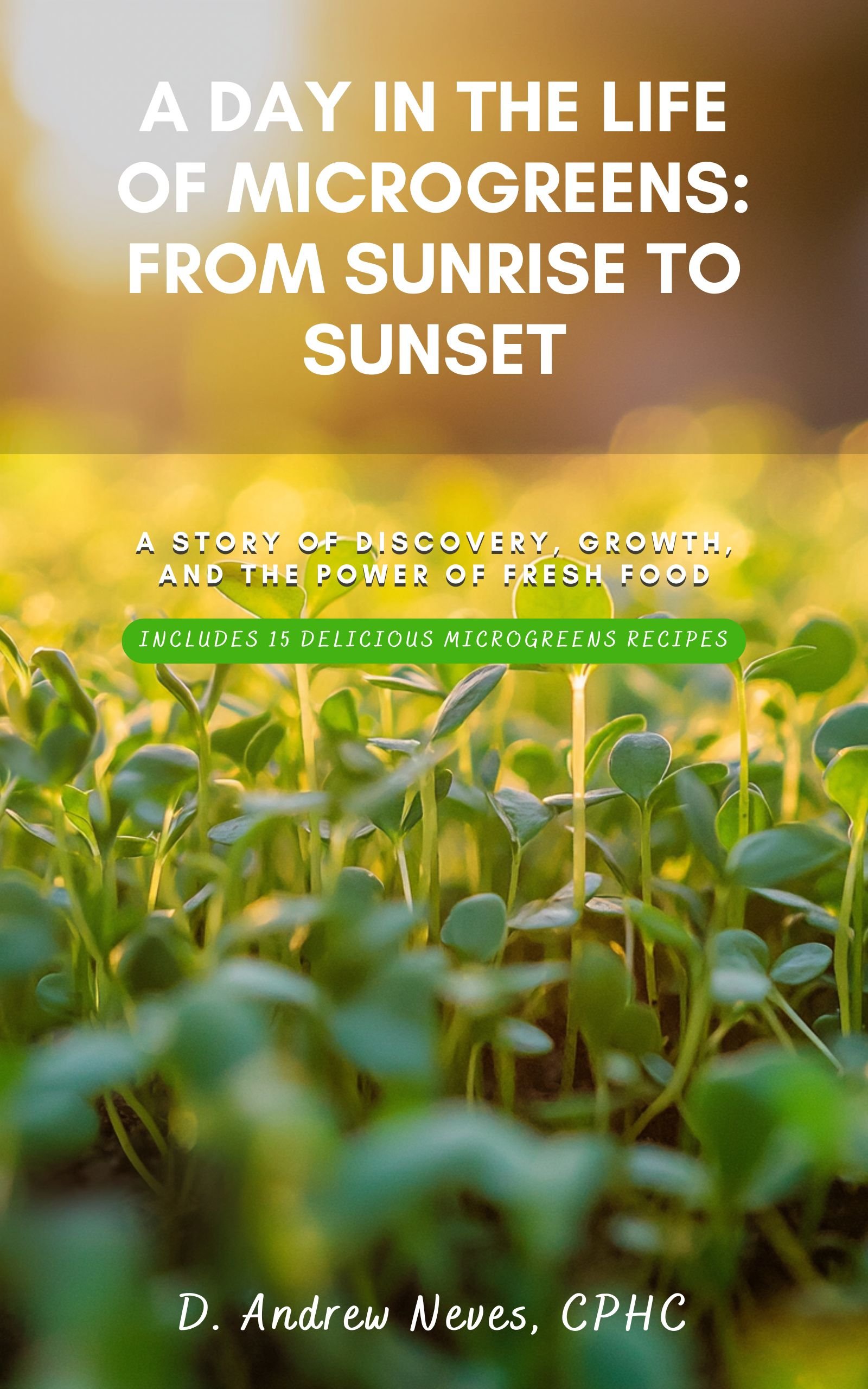A couple of days ago, I got an email from my niece, who’s studying engineering in Virginia. She attached a photograph of a neat row of boxes with cute little plants peeking out—just brushing the surface, really. “I’m a proud mother of 3 different kinds of microgreens now!” her message stated.
Microgreens education programs at universities like UC Davis, Oregon State, and Stony Brook teach hands-on cultivation, sustainability, and nutrition. Students grow microgreens for campus cafeterias while learning biology, hydroponics, and entrepreneurship.
At first, I was confused. Microgreens are healthy, sure, but which kids actually like them? Even most adults I know treat microgreens as fancy decorations that add some color to their meals, something to shake off with a fork. So, what sparked such intense fascination among students of all ages, and how can educators and parents tap into this interest?
Key Takeaways
- Hands-On Engagement: Growing microgreens captivates students of all ages far more effectively than purely theoretical classroom learning approaches.
- University Integration: UC Davis, Oregon State, Stony Brook, and Cornell now incorporate microgreens into sustainability and agriculture curricula.
- Cafeteria Supply: Student-grown microgreens feed campus dining halls, teaching food systems while promoting healthier eating habits schoolwide.
- Youth Entrepreneurship: Ukraine’s Smart Garden program teaches K-12 students business and financial literacy through monthly microgreens sales requirements.
- Simple Startup: Begin with radish, broccoli, or sunflower seeds in shallow trays using LED lights and consistent moisture.
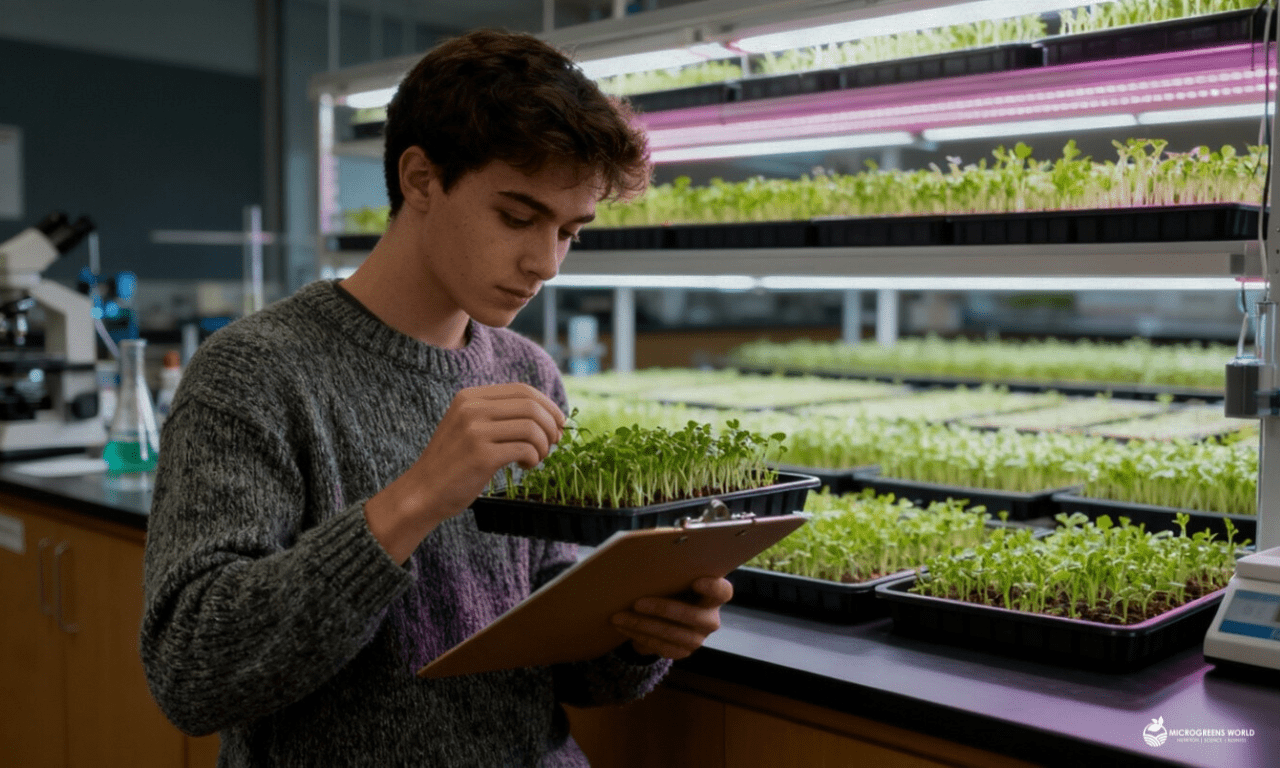
For years, educators have been wondering how to make children and teens genuinely invested in their studies. The challenge? Purely theoretical learning often falls flat. Eyes glaze over. Attention drifts. No inspiration in sight. High school and college students just hire a reliable paper writing service and forget all about it. But give students something living to care for, and everything changes.
Take little kids, those just starting to learn what education even is: ask them to read a book, and they’ll protest to no end. Hand them a pot with a plant, explain how to take care of it, and they’ll love it to death—sometimes literally.
Older students respond the same way. Growing microgreens is becoming one of the most successful hands-on projects across all grade levels.
- UC Davis has a teaching facility for controlled environment agriculture (CEA) that provides students with hands-on experience in indoor growing systems [1].
- Oregon State University has promoted microgreens in education for years, even introducing a program that distributes grow kits across classrooms in different regions [2].
What unites these programs, apart from the focus on microgreens? Their students’ eager participation. Just look at my niece: she never had a single plant, but now she’s delighted to fuss over her microgreens—and she’s getting good grades for it!
The appeal runs just as strong in younger populations. Students at Germantown High School say they learned a lot about plants through their homework, and the benefits of microgreens inspired them to take up farming. An example? It prompted their school to make its menus greener. As student Amanda Estes puts it, “We can feed the entire cafeteria with the lettuce we produce here” [3].
A girl who should be interested in games and hanging out with friends is instead growing microgreens; brilliant K-12 education in action.
Now, we can find microgreens in cafeterias across various campuses, in different states and cities. But what inspired so many youngsters to embrace them rather than shy away?
For kids, it’s all about creating life with their hands and learning how to take care of something. Some children beg their parents for a pet; others ask to take care of little lovely greens instead—all because of the shift toward practical experiments at kindergartens, schools, and colleges.
For older students, the active promotion of sustainability made them pause and think about what they eat. Just look at Cornell University: it offers “menus of change” that include nuts, legumes, and grains, which students have come to love, especially since many have started limiting meat in their diets [4].
In 2024, Cornell Dining celebrated Earth Day by offering a predominantly plant-based lunch, and the enthusiastic reactions took even the organizers aback [5]. As a dining hall manager noted, “Within an hour, all the meals were gone, and I had students coming up to me and asking if there would be more and if we could share some of the recipes. They absolutely loved it.”
So, did microgreens suddenly become tastier than before? I don’t think so. It’s all about creating life, adopting healthier eating habits, and discovering unexpected uses for microgreens.
The Shift toward Sustainability and Better Nutrition
Starting in the 2010s, a growing number of people began caring about sustainability and healthy eating. The change happened in four waves:
- The ugly truth of meat farms caused many young people to become vegetarians. The word “organic” became trendy, along with the idea of a sustainable lifestyle.
- Popular channels and influencers started emphasizing the benefits of microgreens in their videos, drawing attention to antioxidants, nutritional value, and quick growth.
- More research appeared, proving that microgreens contain up to 40 times more vitamins, minerals, and antioxidants than their mature counterparts. As one student noted, “Some of the numbers were really, really high. We thought it might have been a mistake, but we double-checked so many times, and there were no mistakes” [6].
- Content featuring basil, radish, broccoli, arugula, and other microgreens sprouting to life in just a couple of days amazed people all over the world, inspiring them to try growing these baby plants on their own.
Young people, in particular, became more conscious of staying healthy and protecting the environment, which led them to discover the value of microgreens.
Unexpected Uses of Microgreens
Studying microgreens led students to some surprising discoveries. Microgreens play a massive part in skin health, offering real benefits worth noting [7]:
- Microgreens have compounds like sulforaphane and quercetin that help reduce inflammation, promoting skin elasticity and youth.
- Antioxidants like polyphenols and flavonoids help reduce oxidative stress and improve skin health.
- Microgreens like basil and fenugreek are rich in omega-3 fatty acids, improving skin hydration.
- Watercress improves circulation and leads to better oxygenation of the skin, which makes fighting wrinkles simpler.
Modern students worry about their looks, so they start taking care of their skin early on. The discovery that microgreens can help has shifted their perception; many have become even more eager to grow and consume them, and they already report improvements in their skin texture.
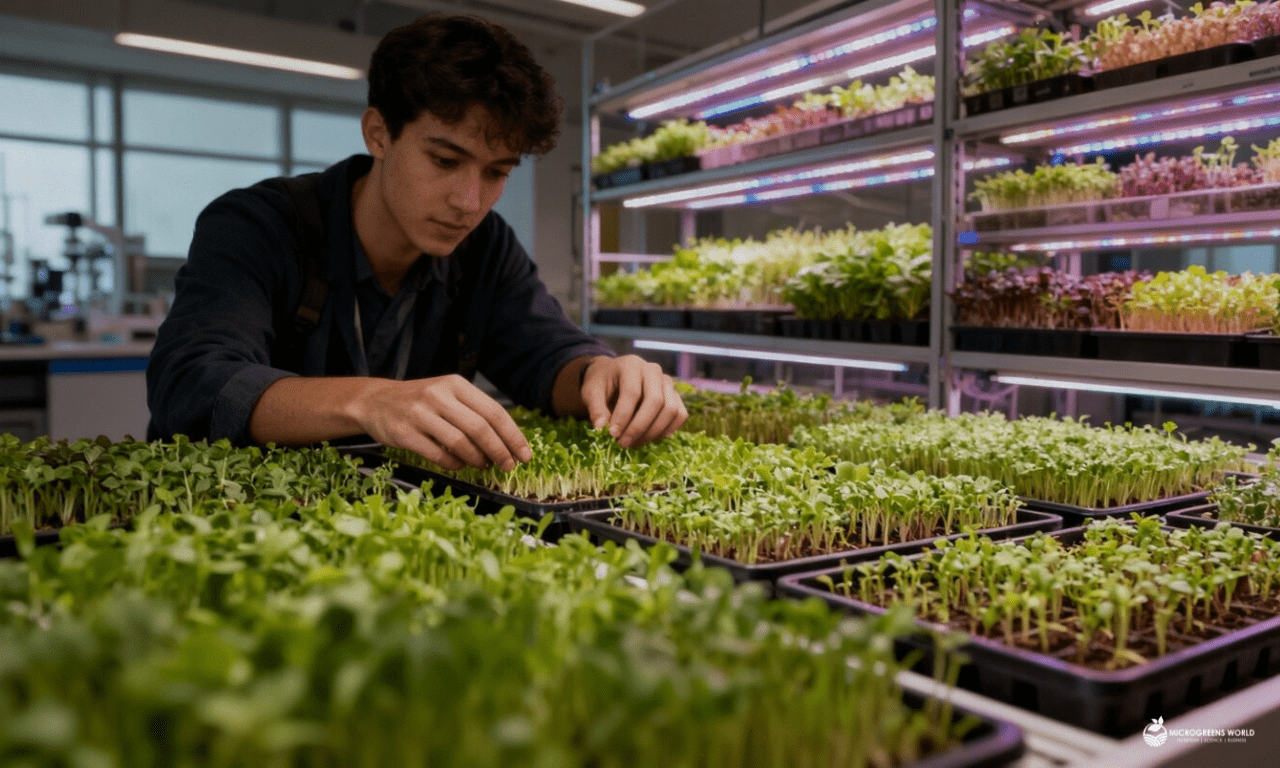
Want to start something similar at your school or college? These two programs might give you ideas.
Stony Brook University: A Micro-Farm at East Side Dining
In 2025, Stony Brook University in New York introduced a new microgreens program for its students [8].
- The goal. Show students what it takes to grow microgreens, from seed to seedling, educate them on all the benefits, and encourage them to eat these locally produced plants in the campus cafeteria.
- The start. The project began in 2025 with Heather Wickham, a recent Stony Brook graduate who wanted to inspire other students to explore the values of micro farms.
- The program isn’t mandatory so that any interested student can join. Many have, although exact numbers remain unclear.
- Microgreens, including green lettuces, bok choy, kale, and other herbs, are harvested weekly and served in cafeterias. All potential participants have to do is express interest and start learning.
- The outcome. According to the SBU Eats director of dining services, students learned to appreciate the beauty of microgreens and “the effort that goes into cultivating them.”
The program was a success. Students started eating healthier foods, learned hydroponic growing techniques, and participated in microgreens cultivation. As organizer Taeyoung (Paul) Kim mentioned, “A crucial component of sustainability is engaging students and making them active participants in the process. When they see the plants growing, their curiosity is sparked. They watch me harvest, ask questions, and I take the opportunity to educate them.”
Pretty inspiring stuff. Imagine how many more students would join such programs if their colleges offered them.
Smart Garden Student Initiative in Ukraine
On the other side of the world, Ukraine launched a K-12 education program called “Smart Garden: Microgreens” in 2020 [9].
- The goal. Teach kids the basics of agronomy, plant cultivation, and financial literacy.
- The start. A small group of children received seeds, fertilizers, and tips from Continental Farmers Group.
- As of now, 300 school children and 15 educational establishments have taken part.
- Every group of children has to sell the microgreens they grow for at least $73 every month.
- During the war. The program didn’t stop. Children started producing dried borscht kits for the Ukrainian Armed Forces using microgreens, vegetables, medicinal herbs, mallow, and marigold.
- The outcome. Children learned how to grow healthy microgreens, earn their first income, and participate in volunteer activities.
The setup? Dead simple. Sponsor companies send equipment, supplies, and seeds to the kids, then check their progress. Those who fail to earn $73 per month are eventually excluded from the program—and let me tell you, this really fuels students’ competitive nature.
Participant Sofia Kolisnyk said, “In the beginning, it was really challenging. Everything was new. We had no experience growing microgreens or running a business. But as time went on, we started to get the hang of it.” That quote alone proves the program’s success: it taught students how to grow valuable plants, operate a business, and reinvest the money they earn.
Growing microgreens is simple. More than that, it’s active, interesting, and engaging enough to appeal to all kinds of learners. I talked with my microgreens-obsessed niece for hours, then spoke to students at different schools and colleges to find out what type of project they’d be interested in. To say I came away with some ideas is an understatement.
Prepare the Micro-Garden Basics
Get the simplest kinds of microgreens: radish, broccoli, or sunflowers. Kids love them. Source? My own children, who haven’t stopped squealing ever since I introduced these greens to them.
Invite the first group of your students and explain the basics: what kind of trays to pick (shallow, 1–2 inches deep), what spot to choose (sunny, or use LED grow lights for 12–14 hours daily), and how to water the microgreens (keep the soil moist without overdoing it).
Assign Leadership Roles
Select “farm managers” and switch them after each cultivation round. Let every child try being a leader: this encourages leadership qualities and increases their investment in the program.
Later, compare results to see who was more successful as a microgreens manager. This will kick off discussions on growth strategies and approaches. I bet it’ll deepen the kids’ knowledge and interest.
Connect Science and Critical Thinking
No matter how old your students are, growing microgreens teaches foundational biology concepts like photosynthesis and plant respiration. For younger ones, use simple words and metaphors—they love this stuff. Let them see for themselves how plants use light and water. What used to be a simple theory becomes an enjoyable practice.
Try using two setups: soil-based versus hydroponic (growing plants in water with nutrients instead of dirt). Students will observe which method works faster. It’s also a great way to encourage children to eat healthier because they all love tasting something they’ve grown.
They’ll learn about nutrient density and plant color changes. Watching their baby greens blossom to life lets students practice critical observation, find joy in experimentation, and sharpen their overall critical thinking.
Create Publicity
Get your students—or children, or both—to turn your mini-garden into the star of mini-documentaries. Show what’s happening in your lab. This is guaranteed to attract more participants to your program.
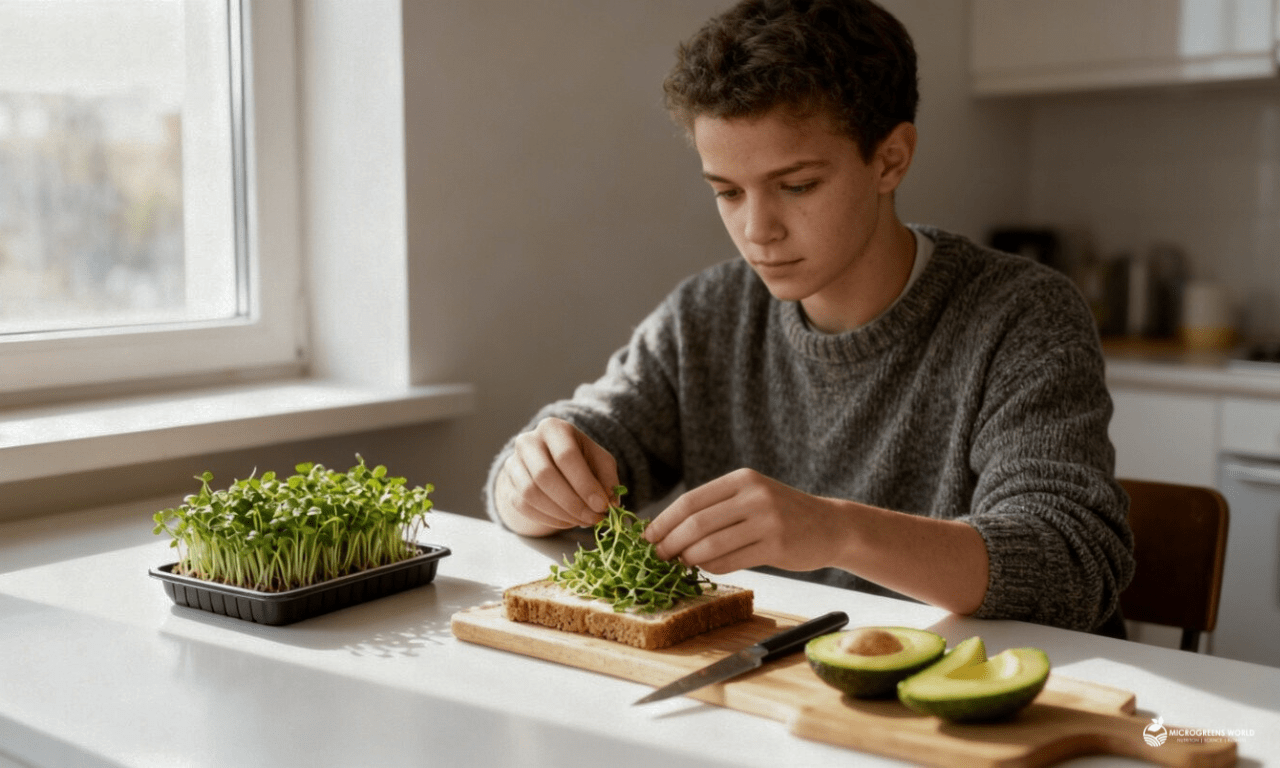
In some ways, microgreens are a lot like children: young and immature, but with limitless potential and value. The vitamins in them can give you an energy boost, improve your skin quality, and delight you with the knowledge that you’re helping cultivate sustainability.
So, what’s the plan? Select the simplest seeds and start growing your microgreens today, along with your students. The greens will be much tastier this way—apart from vitamins, they’ll contain your time, effort, and love.
Frequently Asked Questions
How do I start growing microgreens in the classroom?
Start with beginner-friendly seeds like radish, broccoli, or sunflower in shallow trays (1-2 inches deep). Place in a sunny spot or use LED grow lights for 12-14 hours daily. Keep soil moist without overwatering. Assign rotating “farm managers” among students to build leadership skills and investment in the project.
Are microgreens good for kids?
Yes. Microgreens pack concentrated vitamins and minerals in small, easy-to-eat portions—perfect for picky eaters. Studies show 98% of American children lack adequate phytonutrients. Beyond nutrition, growing microgreens teaches responsibility, biology, and healthy habits. Kids become genuinely excited about eating greens they’ve cultivated themselves.
Where can I find microgreens lesson plans and worksheets?
Oregon State University Extension offers free classroom grow kits and curriculum resources. UC Davis provides teaching materials for controlled environment agriculture. Many state agricultural extension offices publish downloadable PDFs covering seed-to-harvest projects, photosynthesis experiments, and nutrition worksheets for K-12 students at different grade levels.
What is a possible downside to microgreens in schools?
Raw microgreens pose a small risk of bacterial contamination if not grown or appropriately washed. Schools should use soil-based growing (safer than hydroponic sprouts), ensure proper handwashing protocols, and teach students thorough rinsing techniques. Some cruciferous varieties may cause mild digestive discomfort in sensitive children. Budget and short shelf life require planning.
References
- University of California, Davis, College of Agricultural and Environmental Sciences. (n.d.). Controlled environment agriculture. https://caes.ucdavis.edu/research/initiative/controlled-environment-agriculture
- Oregon State University Extension Service. (n.d.). Growing microgreens in the classroom. https://workspace.oregonstate.edu/farm-to-school-and-nutrition-education-growing-microgreens-in-the-classroom
- Milwaukee Journal Sentinel. (2025, October 21). Germantown High School students provide food for the school’s cafeteria. https://www.jsonline.com/picture-gallery/news/education/2025/10/21/germantown-high-school-students-provide-food-for-schools-cafeteria/86754340007/
- Menus of Change. (n.d.). Menus of Change®: The business of healthy, sustainable, delicious food choices. https://www.menusofchange.org/
- Cornell University. (n.d.). Cornell Dining celebrates Earth Day. https://events.cornell.edu/event/cornell-dining-celebrates-earth-day
- University of Maryland, College of Agriculture & Natural Resources. (n.d.). Mighty microgreens. https://agnr.umd.edu/news/mighty-microgreens/
- Neves, A. (2025, January 18). Glowing skin with microgreens – A natural approach to skin health. Microgreens World. https://microgreensworld.com/microgreens-skin-health/
- Stony Brook University. (2025, March 12). Harvesting innovation: SBU Eats introduces on-campus micro-farm. SBU News. https://news.stonybrook.edu/university/harvesting-innovation-sbu-eats-introduces-on-campus-micro-farm/
- Rubryka. (n.d.). Smart City Project. https://rubryka.com/en/article/proyekt-rozumnyj-gorod/
